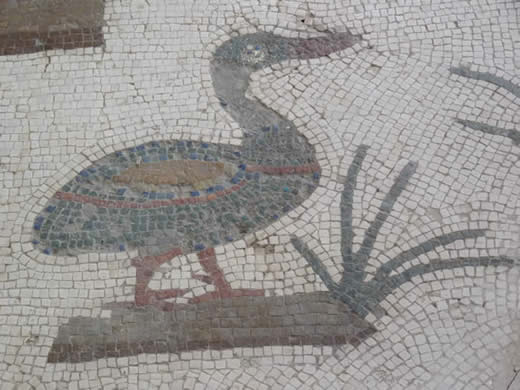DUCK AND OTHER BIRDS
Roman mosaic, Tunisia
This is rather an old-fashioned recipe (it came from Harper’s Bazaar circa 1960), but nonetheless delicious for that and is a good way to do duck-legs.
4 duck legs or breasts
1-2 celery stalks, chopped
2 carrots, peeled and sliced
1 large onion, peeled and sliced
4 fluid oz/100ml cognac
¾ pint/400ml red wine
4 oz/150gr lardons or diced streaky bacon
½ lb/200gr button mushrooms, sliced if large
olive oil, salt, pepper, bouquet garni, garlic
Marinade the duck portions for at least two hours with the red wine, cognac, celery, carrots, onion, salt and pepper. Sauter the bacon in a little olive oil until golden. Remove the duck pieces from the marinade and pat dry. Add them to the bacon and brown on all sides. Then cover and cook gently for 20 minutes. In the meantime, bring the marinade to the boil and simmer for 5-10 minutes. Strain the marinade and pour over the duck. Add a bouquet garni, and two peeled and crushed garlic cloves. Simmer, covered, over a low flame for a further 1½ hours or until the duck is tender. Remove the bouquet garni, skim off the fat, add the mushrooms cooked in a little butter and serve with boiled potatoes.
Roman mosaic
DUCK BREAST WITH PLUM SAUCE (for 2)
2 duck breasts
1 lb plums
4 cloves garlic, peeled and chopped
5 cm ginger root, peeled and grated
2 star anise
2-3 tablespoons soft brown sugar
salt, pepper, chilli powder, soy sauce
Stone and roughly cut up the plums. Cook with a little bit of water, the ginger, garlic, star anise, a pinch of chilli and the sugar, until the plums are soft and disintegrating. Add soy sauce and more sugar to taste; and discard the star anise. Brown the duck breasts on both sides in a lightly oiled frying-pan and then cook for 12-20 minutes in a pre-heated hottish (gas 7/220º) oven. Remove from oven and rest for 10 minutes. Slice and serve with the reheated plum sauce.
DUCK BREAST WITH LIME AND HONEY (for 2-3)
Duck breasts are often quite large, so two are often enough for three. They can be quite tough, so can benefit from prior marinading.
2 duck breasts
½ a lime
1 dessertspoon runny honey
1 pinch ground star anise
¼ teaspoon ground fennel seeds
1 teaspoon soy sauce
Salt and pepper
Heat a small non-stick frying-pan. Season the duck breasts with salt and pepper and pierce the skin in several places with a knife to help the fat run. Place skin-side down in the pan and cook over a fairly high heat for about 6 minutes, turning them once or twice but leaving them mainly skin-side down. Pour off the fat and cook for a further 6-8 minutes at a lower heat. Remove from the pan and leave to rest in a warm place for 5 minutes. Add the zest and juice of the lime to the pan together with the anise, fennel, honey and soy sauce. Cook for a minute or two, stirring, to make a sauce. Slice the duck breasts, arrange on heated serving plates and pour the sauce over the top.
Roman mosaic, Tunisia
4 quail
4 tbsp olive oil
1 tablespoon ground coriander seeds
½ tablespoon ground cumin
½ -1 teaspoon chilli powder
salt
Use some strong kitchen scissors to cut each quail down the centre of its backbone, and open out flat. Rub generously with the olive oil, then rub the spices and salt into the skin. Thread the flattened birds onto skewers and marinate breast side down for at least an hour and preferably overnight. Heat the grill to its hottest, and then grill the quails skinside up for 2-3 minutes. Turn and grill for a further 3 minutes or until all signs of bloodiness have gone. Turn the grill down and grill the birds skinside up for a further 5-6 minutes or until the skin is nicely brown and crispy.
Pigeons at a Roman farmhouse in Tunisia, 3rd century AD.
3-4 whole wild pigeons
2 carrots, peeled and sliced
1-2 onions, peeled and chopped
3-4 sticks celery, chopped
4-8 rashers streaky bacon, derinded and diced
1-2 glasses white wine or 1 glass dry vermouth
2 cloves garlic, peeled and crushed
olive oil, parsley, thyme, bay-leaf, salt, pepper
Soften the onion, carrot, celery and bacon in some olive oil in a saucepan or casserole. Add the pigeons and brown on all sides. Add the wine or vermouth, herbs, salt and pepper and enough water to cover the vegetables and to come about one third way up the pigeons. Simmer, covered, for about 1½ -2 hours. Cut the breasts and legs off the pigeons and return them to the pan, discarding the carcases. Reheat and serve.
This is Samuel Pepys' account of a meal with his wife on 12 May 1667: "...and in our way bethought ourselves of going alone, she and I, to a French house to dinner, and so enquired out Monsieur Robins my periwig-maker, who keeps an ordinary [an eating-house], and in an ugly street in Covent-garden did find him at the door, and so we in; and in a moment almost have the table covered, and clean glasses, and all in the French manner [i.e. the food served in consecutive courses rather than all at once], and a mess of potage first and then a couple of pigeons a l’esteuvé [stewed], and then a piece of boeuf-a-la-mode, all exceeding well seasoned and to our great liking; at least it would have been anywhere else but in this bad street and in a periwig-maker's house; but to see the pleasant and ready attendance that we had, and all things so desirous to please and ingenious in the people, did take me mightily - our dinner cost us 6d."
|
Roman mosaic
